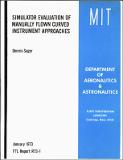| dc.contributor.author | Sager, Dennis Wayne | en_US |
| dc.contributor.other | Massachusetts Institute of Technology. Flight Transportation Laboratory | en_US |
| dc.date.accessioned | 2012-01-06T22:04:02Z | |
| dc.date.available | 2012-01-06T22:04:02Z | |
| dc.date.issued | 1973 | en_US |
| dc.identifier | 13494555 | en_US |
| dc.identifier.uri | http://hdl.handle.net/1721.1/68049 | |
| dc.description | January 1973 | en_US |
| dc.description | Also issued as an M.S. thesis in the Dept. of Aeronautics and Astronautics, MIT, 1973 | en_US |
| dc.description | Includes bibliographical references (p. 122) | en_US |
| dc.description.abstract | Pilot performance in flying horizontally curved instrument approaches was analyzed by having nine test subjects fly curved approaches in a fixed-base simulator. Approaches were flown without an autopilot and without a flight director. Evaluations were based on deviation measurements made at a number of points along the curved approach path and on subject questionnaires. Results indicate that pilots can fly curved approaches, though less accurately than straight-in approaches; that a moderate wind does not affect curve flying performance; and that there is no performance difference between 600 and 90 turns. A tradeoff of curved path parameters and a paper analysis of wind compensation were also made. | en_US |
| dc.format.extent | 122 p | en_US |
| dc.publisher | Cambridge, Mass. : Massachusetts Institute of Technology, Flight Transportation Laboratory, [1973] | en_US |
| dc.relation.ispartofseries | FTL report (Massachusetts Institute of Technology. Flight Transportation Laboratory) ; R73-1 | en_US |
| dc.subject | Instrument landing systems | en_US |
| dc.subject | Flight simulators | en_US |
| dc.title | Simulator evaluation of manually flown curved instrument approaches | en_US |
| dc.type | Technical Report | en_US |
